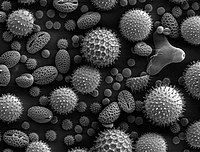
Photo from wikipedia
Sulfate-reducing bacteria (SRB) are the most studied microorganisms related to severe episodes of microbially influenced corrosion (MIC). A mechanism used by SRB to corrode steel alloys is the extracellular electron… Click to show full abstract
Sulfate-reducing bacteria (SRB) are the most studied microorganisms related to severe episodes of microbially influenced corrosion (MIC). A mechanism used by SRB to corrode steel alloys is the extracellular electron transfer (EET), which was described by the biocatalytic cathodic sulfate reduction (BCSR) theory. This theory was supported by several experimental research and some mathematical approaches. However, mathematical modelling that represents the effect of the EET on pit development and the subsequent changes in surface topography has not been reported. In this study, a mechanistic mathematical model of microbial corrosion induced by SRB through EET was developed and implemented. The developed model used data from previously reported experiments to describe the phenomenon and define stoichiometric and kinetic parameters. Results of biofilm development and growth-associated corrosion (i.e. weight loss and maximum pit depths) obtained by simulations were similar to experimental evidence reported in the literature. These simulations reveal that the main parameters that control MIC are the maintenance coefficient of SRB, the initial planktonic cell concentration, and the probability of surface colonization.
Journal Title: Bioelectrochemistry
Year Published: 2022
Link to full text (if available)
Share on Social Media: Sign Up to like & get
recommendations!